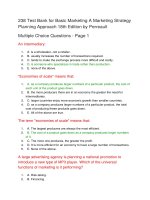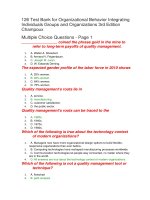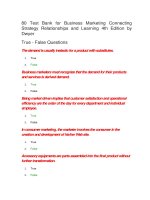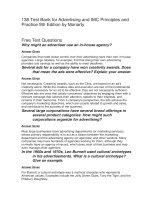Test bank for nursing care of children principles and practice 4th edition by james
Bạn đang xem bản rút gọn của tài liệu. Xem và tải ngay bản đầy đủ của tài liệu tại đây (525.36 KB, 15 trang )
Link ful download: />
Test Bank for Nursing Care of Children Principles and Practice 4th
Edition by James
Chapter 12: The Child with a Chronic Condition or Terminal Illness
MULTIPLE CHOICE
View Sample
1. A family has just learned their child has cystic fibrosis. They told the nurse
“this won’t change anything, our child is not that sick.” The nurse recognizes
that the family is in which stage of the grieving process?
a.
Anger and resentment
b.
Sorrow and depression
c.
Shock and disbelief
d.
Acceptance and adjustment
ANS: C
According to Kübler-Ross, denial is the initial stage of the grieving process when an
individual reacts with shock and disbelief to the diagnosis of a chronic illness.
Feelings of anger, resentment, sadness, and depression are part of the grieving
process, after the initial response of shock and disbelief. Acceptance is the final stage
of the grieving process.
DIF: Cognitive Level: Comprehension REF: p. 252
OBJ: Nursing Process Step: Assessment MSC: Psychosocial Integrity
2. A nurse is planning care for a dying child. Which priority intervention is
planned to address the primary concern parents have for the dying child?
a.
Pain
b.
Safety
c.
Food intake
d.
Fluid intake
ANS: A
The primary concern of all parents of dying children is the possibility of their child
feeling pain. Although safety, eating, and hydration are important, they are not the
priority concern.
DIF: Cognitive Level: Application
OBJ: Nursing Process Step: Planning
REF: p. 264
MSC: Physiological Integrity
3. A parent of an infant states that she will room-in while her child is
hospitalized. The nurse supports her decision knowing that the major fears of
infants during illness and hospitalization are:
a.
bodily injury and pain.
b.
separation from caregivers and fear of strangers.
c.
loss of control and altered body image.
d.
the unknown and being left alone.
ANS: B
The major fear of infants during illness and hospitalization are separation from
caregivers and fear of strangers. Bodily injury and pain are fears of preschool and
school-age children. Loss of control is a fear of children from the preschool period
through adolescence. Altered body image applies to adolescents. Fear of the
unknown and being left alone are applicable to preschoolers.
DIF: Cognitive Level: Comprehension REF: p. 254
OBJ: Nursing Process Step: Evaluation MSC: Psychosocial Integrity
4. A nurse has just completed a teaching session for parents about children’s
understanding of death. Parents of a 5-year-old child understood the teaching
if they indicate which corresponds to their child’s understanding of death?
a.
Loss of a caretaker
b.
Reversible and temporary
c.
Permanent
d.
Inevitable
ANS: B
Children in early childhood (2 to 7 years old) view death as reversible and
temporary. Toddlers view death as loss of a caretaker. The school-age child and
adolescent understand death is permanent. The adolescent understands death not
only as permanent, but also inevitable.
DIF: Cognitive Level: Application
REF: p. 260
OBJ: Nursing Process Step: Evaluation MSC: Psychosocial Integrity
5. A nurse plans to include family in the aspects of care for a dying 12-monthold child. The nurse bases this plan on the understanding that death for an
infant is understood as:
a.
temporary.
b.
permanent.
c.
loss of caretaker.
d.
punishment.
ANS: C
Infants and toddlers view death as loss of a caretaker. The preschool-age child views
death as temporary. The school-age child and adolescent understand the
permanence of death. The preschool-age child facing impending death may view his
or her condition as punishment for behaviors or thoughts.
DIF: Cognitive Level: Comprehension REF: p. 260
OBJ: Nursing Process Step: Planning
MSC: Psychosocial Integrity
6. Which activity should the nurse implement for the toddler hospitalized with a
chronic illness to promote autonomy?
a.
Playing with a push-pull toy.
b.
Putting a puzzle together.
c.
Playing a simple card game.
d.
Watching cartoons on TV.
ANS: A
Chronic illness may interfere in the development of autonomy, which is the major
psychosocial task of the toddler. The developmentally appropriate activity for the
hospitalized toddler is to play with a push-pull toy. Putting a puzzle together and
playing a simple card game could frustrate the toddler and are appropriate for a
preschool or school-age child. Watching cartoons on TV is passive and will not
promote autonomy.
DIF: Cognitive Level: Application
REF: p. 254
OBJ: Nursing Process Step: Implementation
Integrity
MSC: Psychosocial
7. How can chronic illness and frequent hospitalization affect the psychosocial
development of an adolescent?
a.
They can lead to feelings of inadequacy.
b.
They can interfere with parental attachment.
c.
They can block the development of identity.
d.
They can prevent the development of imagination.
ANS: C
Development of identity is the task of the adolescent. Inadequacy and inferiority
refer to the school-age period. Parental attachment is a task of the infant.
Development of imagination occurs in the preschool period.
DIF: Cognitive Level: Comprehension REF: p. 254
OBJ: Nursing Process Step: Assessment MSC: Psychosocial Integrity
8. Which is an important focus of nursing care for the dying child and his or her
family?
a.
Nursing care should be organized to minimize contact
with the child.
b.
Adequate oral intake is crucial to the dying child.
c.
Families should be made aware that hearing is the last
sense to stop functioning before death.
d.
It is best for the family if nursing care takes place
during periods when the child is alert.
ANS: C
Families should be encouraged to talk to the child because verbal communication
and physical touch are important both for the family and child. Nursing care should
minimize disruptions but not contact. When a child is dying, fluids should be based
on the child’s requests, with a focus on comfort and preventing a dry mouth. The
times when the child is alert should be devoted to family contacts.
DIF: Cognitive Level: Application
OBJ: Nursing Process Step: Planning
REF: p. 265
MSC: Psychosocial Integrity
9. What is the most appropriate response to a school-age child who asks if she
can talk to her dying sister?
a.
“You need to talk loudly so she can hear you.”
b.
“Holding her hand would be better because at this
point she can’t hear you.”
c.
“Although she can’t hear you, she can feel your
presence so sit close to her.”
d.
“Even though she will probably not answer you, she
can still hear what you say to her.”
ANS: D
Hearing is the last sense to cease before death. Talking to the dying child is
important both for the child and the family. The sibling should be encouraged to
speak to the child as well as hold the child’s hand.
DIF: Cognitive Level: Application
REF: p. 265
OBJ: Nursing Process Step: Implementation
Integrity
MSC: Psychosocial
10. The nurse recognizes that the priority goal for the child with a chronic illness
is to:
a.
maintain the intactness of the family.
b.
eliminate all stressors.
c.
achieve complete wellness.
d.
obtain the highest level of wellness.
ANS: D
To obtain the highest level of health and function possible is the priority goal of
nursing of children. Maintaining the intactness of the family is a goal for the family,
not specifically the child. It is not a realistic goal to eliminate all stressors because
life will continue to present stressors. It is also unrealistic to achieve complete
wellness because chronic illness by definition is a long-term condition either
without a cure or with residual limitations.
DIF: Cognitive Level: Comprehension REF: pp. 253-254
OBJ: Nursing Process Step: Planning
MSC: Health Promotion and Maintenance
11. Which is the predominant trait of the resilient family associated with chronic
illness?
a.
Social separation
b.
Family flexibility
c.
Family cohesiveness
d.
Clear family boundaries
ANS: C
Family cohesiveness is the predominant trait of the resilient family. Maintaining
social integration is one of the traits of a resilient family system. Family flexibility
and clear family backgrounds are traits of the resilient family, but not the
predominant one.
DIF: Cognitive Level: Knowledge
REF: p. 251
OBJ: Nursing Process Step: Assessment MSC: Psychosocial Integrity
12. Parents express recurrent feelings of grief, loss, and fear related to their
child’s chronic condition. The nurse understands that this is:
a.
anticipatory grieving.
b.
chronic sorrow.
c.
bereavement.
d.
illness trajectory.
ANS: B
The stated recurrent feelings define chronic sorrow, which is considered a normal
process involving grief that may never be resolved. Anticipatory grieving is the
process of mourning, coping, interacting, planning, and psychosocial reorganization
that is begun as a response to the impending loss of a loved one. Bereavement is
defined as the objective condition or state of loss. Illness trajectory is defined as the
impact of the disease or condition on all family members, physiological unfolding of
the disease, and work organization done by the family to cope.
DIF: Cognitive Level: Comprehension REF: p. 252
OBJ: Nursing Process Step: Assessment MSC: Psychosocial Integrity
13. Which would be a priority nursing diagnosis for the child with chronic
illness?
a.
Risk for delayed development related to chronic
illness or disability
b.
Chronic pain related to frequent injections
c.
Anticipatory grieving related to impending death
d.
Anxiety related to frequent hospitalizations
ANS: A
Risk for delayed development related to chronic illness or disability is the priority
nursing diagnosis that would be appropriate for the majority of children with
chronic illnesses. Pain is not associated with the majority of chronic illnesses. A
chronic illness is one that does not have a cure. It does not mean the child will die
prematurely. Frequent hospitalizations are not required for all chronic illnesses.
DIF: Cognitive Level: Application
REF: p. 253
OBJ: Nursing Process Step: Nursing Diagnosis
MSC: Health Promotion and Maintenance
14. Which is the most appropriate response for the nurse when parents say that
“living with this disease our child has is really hard; it’s not fair”?
a.
“Tell me about what is hard for you.”
b.
“I know exactly how you must feel.”
c.
“I know a local support group for families.”
d.
“I am going to ask the grief counselor to meet with
you.”
ANS: A
The first step in supporting families and helping them deal with chronic sorrow is to
listen to and recognize their pain. Telling the parents that you know how they must
be feeling would not encourage parents to talk about their feelings. Each individual’s
perception of a situation is different. A nurse can never know exactly how parents
feel about having a child with a chronic illness. “I know a local support group for
families” and “I am going to ask the grief counselor to meet with you” do not address
the parent’s immediate feelings.
DIF: Cognitive Level: Application
REF: p. 252
OBJ: Nursing Process Step: Implementation
Integrity
MSC: Psychosocial
15. Which is the most appropriate response to a parent who tells the nurse, “I
don’t want my child to know she is dying?”
a.
“I shall respect your decision. I won’t say anything to
your child.”
b.
“Don’t you think she has a right to know about her
condition?”
c.
“Would you like me to arrange for the physician to
speak with your child?”
d.
“I’ll answer any questions she asks me as honestly as I
can.”
ANS: D
Nurses can inform parents that they will not initiate any discussion with the child
but that they intend to respond openly and honestly if and when the child initiates
such a discussion. As the caregiver and advocate, the nurse should first meet the
child’s needs. “Would you like me to arrange for the physician to speak with your
child” does not address the parent’s wishes.
DIF: Cognitive Level: Application
REF: p. 263
OBJ: Nursing Process Step: Implementation
Integrity
MSC: Psychosocial
MULTIPLE RESPONSE
1. Which indicators of imminent death in a child should the nurse expect to
assess? Select all that apply.
a.
Heart rate increases.
b.
Blood pressure increases.
c.
Respirations become rapid and shallow.
d.
The extremities become warm.
e.
Peripheral pulses become stronger.
ANS: A, C
Indicators of imminent death include the heart rate increasing, with a concomitant
decrease in the strength and quality of peripheral pulses; respiratory effort declines,
as evidenced by rapid, shallow respirations; and extremities are cool and cyanotic.
DIF: Cognitive Level: Comprehension REF: p. 252
OBJ: Nursing Process Step: Assessment MSC: Physiological Integrity
OTHER
1. Place the stages of grieving in order starting with the initial stage and ending
with the final stage.
2. Anger
3. Depression
4. Denial
5. Acceptance
6. Bargaining
ANS:
C, A, E, B, D
The stages of grieving, in order, include denial, anger, bargaining, depression, and
acceptance.
DIF: Cognitive Level: Analysis
REF: p. 266
OBJ: Nursing Process Step: Evaluation MSC: Psychosocial Integrity









